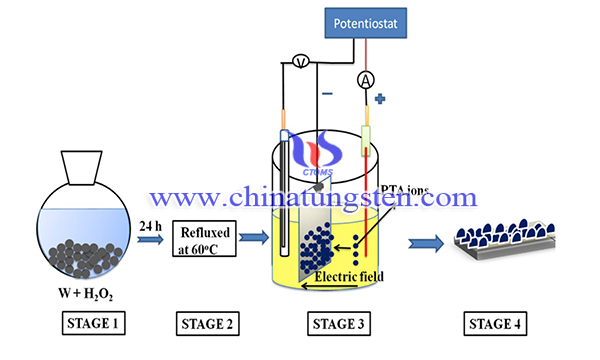WO3 Nanostructured Thin Films for H2S Gas Sensor Applications
- Details
- Category: Tungsten Information
- Published on Thursday, 21 October 2021 00:39
High-performance gas sensors are receiving more and more attention due to their wide application in pollutant detection, medical diagnosis, chemical monitoring, food processing and other fields. Tungsten oxide (WOx) has received considerable attention as a promising sensing material due to its high sensitivity and stability, specifically towards hydrogen sulfide (H2S) gas. Various WO3 nanostructures such as nanoparticles, nanowhisker, nanorods, and nanowires have shown enhanced sensing properties towards different gases.
It is reported that WO3 nanostructured thin films for H2S gas sensor applications has been successfully optimized by using a simple template of PTA solution and a surfactant-free electrodeposition method. The preparation process is as below:

First, FTO substrate was washed with acetone, ethanol, and distilled water in an ultrasonic bath for 15 minutes. WO3 sol is prepared by dissolving 1.25g H2WO4 in 20ml H2O2, adding 0.2g polyvinyl alcohol, and stirring for 6 hours. The prepared sol was spin-coated on the FTO-coated glass substrate at a speed of 3000 rpm for 30 seconds, and then repeated 4 times, and then heated in a muffle furnace at 500°C in air for 2 hours. A three-electrode electrochemical system is used for electrodeposition at room temperature, platinum wire is used as the counter electrode, Ag/AgCl is used as the reference electrode and FTO coated glass, and the WO3 seed layer is used as the working electrode (3 × 1.5 cm-2). Electrodeposition Perform a potentiostat on the reference electrode at room temperature at -0.45 V without stirring for 30 minutes. The resulting film was immediately rinsed with distilled water and dried in air. Then the electrodeposited film was annealed in the muffle furnace at 450°C in air for 2 hours, and then the structure characterization and electrochromic study were performed.

In conclusion, The as-prepared WO3 nanostructured thin films shows excellent electrochromic properties, showing greater optical modulation (68.89% at 550 nm), faster response time (tb = 1.93 s, tc = 2.87 s), and higher coloring efficiency ( About 154.93 cm2 C-1) and excellent cycle stability over 2000 cycles without any degradation. In addition, the WO3 nanosheet array film shows a good response towards H2S detection. The significant increase in porosity and high surface roughness may contribute to this excellent and superior electrochromic characteristics and gas sensing performance. These results show that the WO3 nanosheet array film manufactured through a simple strategy has broad prospects for potential multi-functional applications such as smart windows, gas sensors and optical sensors.
- Tungsten Oxide Manufacturer & Supplier, Chinatungsten Online: www.tungsten-oxide.com
- Tungsten News & Prices of China Tungsten Industry Association: www.ctia.com.cn
- Molybdenum News & Price: news.molybdenum.com.cn
- Tel.: 86 592 5129696; Fax: 86 592 5129797; Email: sales@chinatungsten.com



 sales@chinatungsten.com
sales@chinatungsten.com